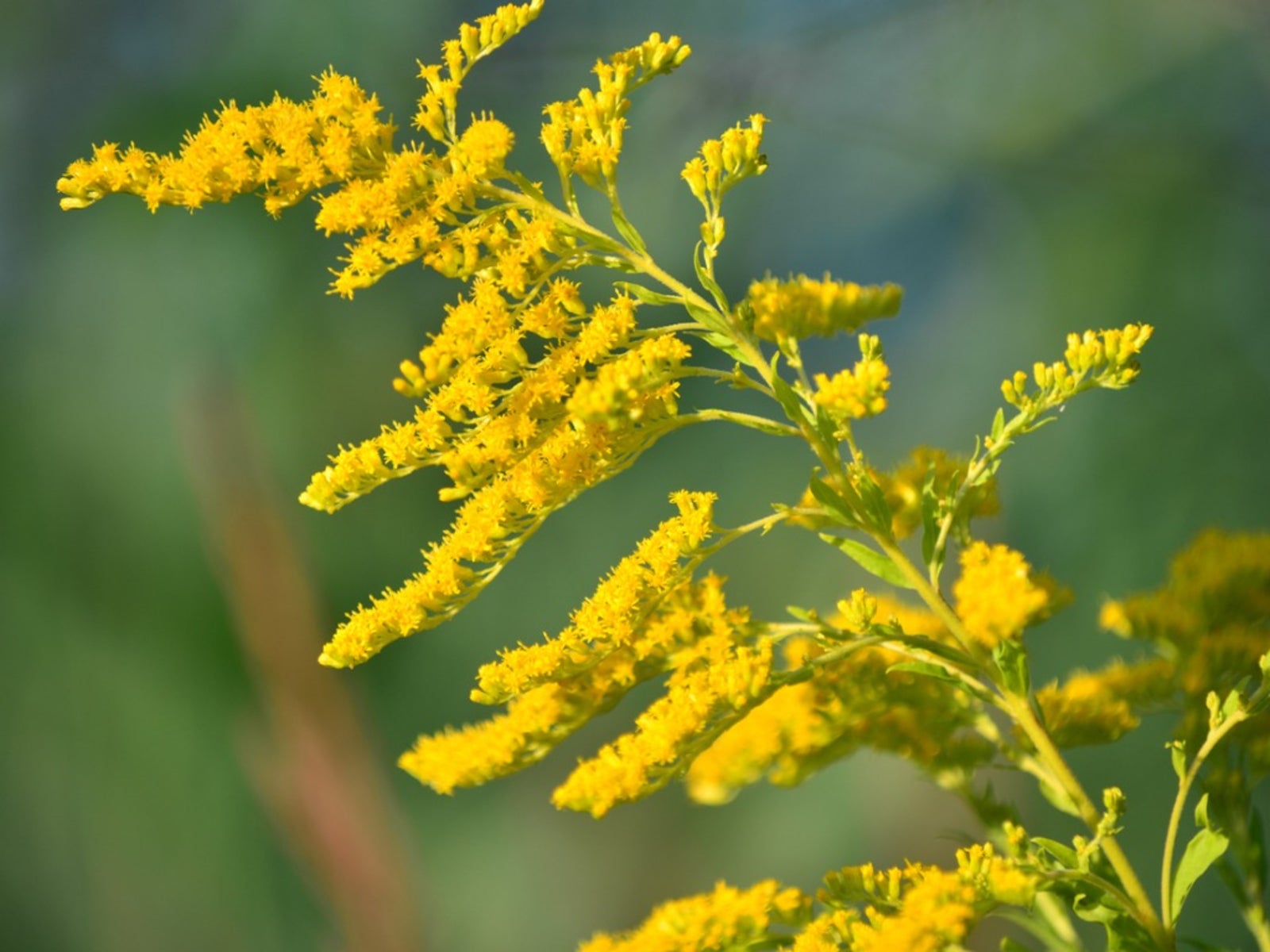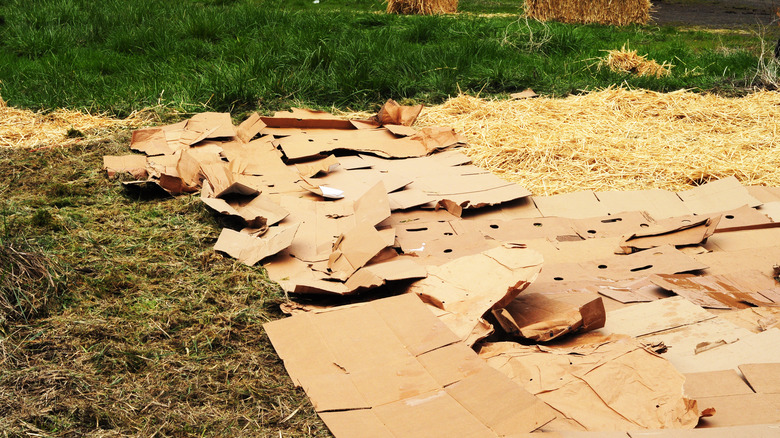Goldenrod can be a divisive plant. Even though the yellow flowering “weed” is a beneficial native plant to North America, it is also very aggressive and can be hard to get rid of because it often spreads through rhizomes. Luckily, you can get rid of goldenrod without hurting your soil by covering it with cardboard rolled up like sheet mulch.
Goldenrod can refer to several species in the Solidago genus and is often confused with ragweed (Ambrosia artemisiifolia). Unlike ragweed, goldenrod is not likely to cause allergies. It can be a great addition to pollinator gardens because it is a main food source for many native bees and other pollinator species. There are types of goldenrod that can grow in zones as low as 2, so it’s likely that it will grow in your area, good or bad. Many species of goldenrod spread by both seeds and rhizomes, allowing them to rapidly take over an area. For that reason, its suggested to grow goldenrod only in a contained area.
Goldenrod is a tall yellow wildflower that grows in a variety of environments across North America. While appreciated by some for its bright color and nectar production that supports pollinators, goldenrod is considered an aggressive weed by many gardeners and landowners.
This article provides a comprehensive guide to identifying goldenrod and techniques for controlling and removing it permanently from your yard or garden.
Identifying Goldenrod Plants
There are over 100 species of goldenrod (Solidago spp.) but they share some common characteristics that aid identification:
- Herbaceous perennial that dies back each winter
- Single unbranched stems grow 1-7 feet tall
- Alternating leaves are slender and pointed
- Dense clusters of tiny yellow flowers bloom late summer into fall
- Spread aggressively via rhizomatous roots and windblown seeds
Two of the most common nuisance goldenrod species are Canada goldenrod (Solidago canadensis) and giant goldenrod (Solidago gigantean). Both tend to take over open areas like fields roadsides, disturbed sites, and unmowed lawns. Goldenrod also invades gardens by creeping in via underground rhizomes.
Removal Methods
Eliminating established goldenrod stands takes persistence but can be accomplished through various organic and chemical control methods:
Manual Removal
For small infestations, manually dig up and remove plants. Use a garden fork or shovel to loosen the soil. Trace rhizomes and extract the entire root system. Discard plant debris in sealed bags, not in compost piles. Follow up periodically to uproot new seedlings.
Cutting/Mowing
Frequently mowing or cutting goldenrod prevents flowering and stops seeds from spreading Remove cuttings to avoid sprouting Repeated cutting depletes root reserves so plants eventually die, Don’t mow when seed heads are present,
Smothering
Smother goldenrod by depriving it of light. Cover areas thickly with mulch, cardboard, or landscape fabric. Leave covered for at least one growing season. Combine with manual root removal for best results.
Prescribed Burns
Burning is effective at controlling goldenrod dominant sites like prairies and meadows. Conduct burns before growth begins in spring or after flowering concludes in late fall to avoid spreading seeds.
Herbicides
Systemic herbicides that kill roots, like glyphosate (Roundup), provide chemical control if applied late summer or fall. Always follow label directions. Avoid spraying near desirable plants or around water sources.
Prevention Tips
Proper landscape management can help prevent goldenrod infestations:
- Maintain healthy turf and garden beds to prevent bare areas
- Mulch and replant bare spots
- Remove goldenrod plants before they go to seed
- Minimize soil disturbance that allows seeds to germinate
- Plant native grasses and wildflowers suited to the site
Goldenrod spreads readily in neglected fields, along fencerows, and roadsides. Keeping areas mowed or planting competitive grasses and groundcovers helps suppress goldenrod. Be vigilant in pulling young plants in gardens before rhizomes become established. With persistence using cultural, mechanical and chemical controls, goldenrod can be successfully eliminated from areas where it is undesirable.
Common Questions
Does goldenrod cause hayfever?
No, goldenrod pollen is too heavy and sticky to become airborne. Ragweed, which blooms at the same time, is the culprit behind “goldenrod hayfever.”
Is goldenrod beneficial?
Goldenrods provide late season nectar for bees, butterflies, and other pollinators. Birds eat the seeds. Deer will graze on the foliage. Some species are larval host plants. So it does have ecological benefits in natural areas if kept in check.
How long until goldenrod dies after being cut down?
It may take 1-2 years of repeatedly cutting goldenrod during the growing season before the underground rhizomes are exhausted and the plants die out completely.

Using cardboard sheet mulch to eradicate goldenrod

Sheet mulching is a popular and practical method for eliminating large areas of weeds and grasses. Putting cardboard over a big patch of goldenrod that you want to get rid of might be the best way to do it. First, mow the goldenrod down as close to the ground as you can. Then, use a hose or sprinkler to wet the area. Then, prepare your cardboard. Yes, its finally time to use those empty boxes that have been taking up space in your garage.
Cut the cardboard into flat pieces, and remove any tape, staples, or other inorganic material. Once you have your cardboard sheets, lay them out on top of the goldenrod-infested ground. Make sure the cardboard pieces overlap so that weeds can’t grow through any cracks or holes. Be sure to secure your cardboard down with either landscape staples or heavy rocks.
Next, simply put soil and wood chips over the cardboard and begin your new garden. The cardboard should prevent the goldenrod from growing, smothering the unwanted weeds. As the cardboard slowly decomposes, it should nourish the soil, resulting in a healthy garden.
control of canada goldenrod in prairie restoration pt 2
- A Complete Guide to Caring for Yuki Cherry Blossom Shrub - January 23, 2025
- Identifying Red Hot Poker Seeds: What to Look For When Harvesting Torch Lily Pods - January 23, 2025
- A Complete Guide to Harvesting Evening Primrose Seeds - January 23, 2025
